Multidimensional Taxonomies for Research, Development, and Implementation of Electric Aircraft Ecosystem
Abstract
:1. Introduction
- The research introduces a unique, multidimensional taxonomy framework that systematically categorizes electric aircraft technologies, including propulsion systems, energy management strategies, infrastructure requirements, and regulatory factors. These taxonomies serve as a crucial tool for organizing the rapidly evolving knowledge in electric aviation, facilitating interdisciplinary communication and guiding further research.
- The study incorporates predictive models that assess the impact of electric aviation on regional transport networks. These models help to forecast infrastructure needs, stakeholder engagement, and market adoption. Such models are critical for planning the expansion of electric aviation and understanding its socio-economic and environmental impacts at the regional level.
- In addition to technological aspects, this research introduces innovative business models that consider the unique dynamics of electric aviation. These models emphasize the role of stakeholders in the value chain, operational frameworks for electric aviation companies, and the development of new market opportunities, highlighting pathways for commercialization and adoption.
- The study emphasizes the full lifecycle of electric aircraft technologies, from design and development to decommissioning and recycling. This lifecycle approach ensures that sustainability is integrated at every stage of electric aviation development, aligning with global environmental goals.
2. Related Works
2.1. Electric Propulsion Systems and Technologies
2.2. Energy Management and Efficiency Strategies
2.3. Predictive Modeling and Future Trends
2.4. Solar-Powered Electric Planes
3. Taxonomy-Based Approach for Comprehensive Study of Electric Aviation
- Taxonomies provide a structured way to categorize and organize a large body of knowledge, which is essential in a field like electric aviation where research and development are rapidly evolving. This systematic organization helps in identifying gaps in current knowledge and potential areas for further research.
- By creating categories within taxonomies, researchers can more easily compare different aspects of electric aviation, such as technology types, regulatory challenges, or market trends. This comparative analysis is fundamental to scientific inquiry, allowing for the identification of patterns, relationships, and inconsistencies.
- Taxonomies create a common language for researchers, industry professionals, and policymakers. This is particularly important in interdisciplinary fields like electric aviation, where experts from different areas (e.g., engineering, environmental science, economics) need to collaborate. Clear categorization improves the efficiency and clarity of communication among diverse stakeholders.
- With a well-structured taxonomy, researchers can more effectively model different scenarios and predict future developments in electric aviation. This is crucial for strategic planning, policy development, and investment in the field.
- Taxonomies allow for the aggregation and synthesis of existing research, making it easier to conduct meta-analyses and systematic reviews. These are important tools in scientific research for assessing the state of knowledge on a topic, determining consensus, and identifying areas where opinions or findings diverge.
- By systematically categorizing information, researchers can track the evolution of technology and industry practices over time. This historical perspective is important for understanding how the field has developed and where it might be headed.
4. Results
4.1. Classification of Electrical Aviation Based on the Primary Source of Electrical Power
- Battery-electric aircraft utilize batteries as the sole energy storage and power source. Battery-electric aircraft use only rechargeable batteries as their primary source of energy to power electric motors for flight. These aircraft are typically limited in range due to current battery technology, but they offer benefits such as zero emissions during operation and lower noise levels. Batteries are recharged from an external source between flights. Current lithium-ion batteries offer high efficiencies but low energy density. This category encompasses aircraft that solely utilize batteries charged from an external source as their powerplant. Lithium-ion batteries are the dominant technology, providing high efficiencies but relatively low energy density compared to aviation fuel. For most designs, batteries are recharged while the aircraft is stationary between flights. Battery-electric aircraft are the most common type today owing to the maturity of lithium-ion technology. Limitations in energy density constrain range and payload capacity compared to conventional airplanes. Flight times under 1 h are typical. Ongoing improvements in energy density will expand capabilities over time.
- Hydrogen fuel cell-electric aircraft employ compressed hydrogen as an energy carrier, converting it to electricity via proton-exchange fuel cells onboard. These aircraft utilize hydrogen as an energy source, converting it into electricity via fuel cells to power electric motors. Hydrogen fuel cells offer a higher energy density compared to batteries, allowing for longer flight durations. However, they come with challenges such as the storage of hydrogen and the complexity of fuel cell systems. Fuel cells offer 2–3× the energy density of batteries but at a higher overall system complexity. These aircraft employ compressed gaseous hydrogen as the onboard energy carrier. The hydrogen is converted to electricity by proton-exchange membrane fuel cells distributed throughout the aircraft. Fuel cells offer 2–3× the energy density of batteries. Water vapor is the only byproduct. The primary challenges are storage of compressed hydrogen and the complexity of fuel cell systems. Cryogenic liquid hydrogen has also been proposed but introduces additional efficiency losses. Fuel cells may enable longer flight times measured in hours.
- Solar-electric aircraft supplement batteries with photovoltaic cells to directly convert solar irradiation to electricity for partial propulsion and battery recharging. Feasible for long endurance applications. This type combines batteries with photovoltaic cells spread across the aircraft surface to collect solar energy during flight. The photovoltaic cells provide partial power for propulsion and recharging of batteries. Solar aircraft are designed for very long endurance applications like high-altitude communications relays. Energy is limited to daytime operation under solar illumination. Wing structure design must account for photovoltaic cell integration.
4.2. Classification of Electrical Aviation Based on the Overall Aircraft Design
- Conventional electric airplanes as existing aviation platforms retrofitted with electric propulsion technologies. This subcategory extends the legacy of traditional fixed-wing aircraft, modified to be powered by electric motors. With designs that are familiar to the aviation industry, these aircraft are suited for a variety of roles, from training and recreational flying to regional commercial transport. The advantages of electric propulsion, such as reduced noise and lower operational costs, make these aircraft an attractive option for airlines and pilots alike.
- Electric Vertical Take-Off and Landing (eVTOL) aircraft—novel vertical take-off and landing concepts enabled by electric propulsion, such as multicopters. The eVTOL subcategory represents a transformative approach to aviation, with aircraft capable of taking off and landing vertically like a helicopter but with the efficiencies of fixed-wing flight. eVTOLs are at the forefront of urban air mobility, envisioned to alleviate congestion in metropolitan areas by taking transportation to the skies. Urban air mobility refers to the use of eVTOL aircraft for short-distance travel within urban areas with the aim of reducing traffic congestion and improving mobility by offering on-demand air taxi services and other innovative transportation solutions. eVTOLs are also being developed for cargo delivery and emergency services, demonstrating versatility across various applications.
- Electric Short Take-Off and Landing (eSTOL) aircraft use electric propulsion for short take-off and landing from small runways. eSTOL aircraft are designed to operate from shorter runways, expanding access to areas with limited infrastructure. They strike a balance between the range and speed of conventional aircraft and the versatility of VTOL designs. eSTOL aircraft could serve as a sustainable solution for regional travel, connecting smaller communities with larger transport hubs.
- UAVs, or drones, often cater to vastly different market needs and applications compared to manned electric aircraft. While electric UAVs are crucial in sectors like surveillance, agriculture, delivery services, and photography, the discussed issues in electric aviation are centered on passenger and cargo transport, regional connectivity, and commercial aviation dynamics. These are areas where manned aircraft play a more direct and significant role.
- The regulatory and policy landscape for manned electric aviation is markedly different from that of unmanned aerial systems. Given that one of the paper’s aims is to delve into the policy implications and strategic recommendations for electric aviation, it was important to concentrate on areas where regulatory evolution is most pressing in the context of passenger and cargo transport. UAVs, while subject to regulatory considerations, operate under a different set of rules and frameworks.
- The infrastructure and technology developments necessary for supporting manned electric aircraft, such as charging stations, vertiports, and adaptation of existing airports, differ significantly from those required for UAV operations. The paper seeks to address specific challenges and advancements related to infrastructure for larger-scale electric aircraft, which is a critical aspect of developing electric aviation for regional connectivity and commercial operations.
- The primary objective is to explore the potential and challenges of electric aviation in enhancing regional transport networks and commercial air travel. This includes exploring the feasibility, market potential, and environmental impacts of electric aircraft in passenger and cargo transportation, areas where manned aircraft are central.
- Including UAVs in the discussion would have broadened the scope of the analysis considerably, potentially diluting the focus and depth of exploration into the specific challenges and opportunities of manned electric aviation. By concentrating on manned aircraft, the paper provides a more in-depth and targeted analysis of the issues most pertinent to this segment of the aviation industry.
4.3. Ecosystem of Electrical Aviation
4.4. Main Directions of Scientific Research in Electric Aviation Area
4.4.1. Advances in Battery Technology
4.4.2. Innovation in Electric Propulsion Systems
4.4.3. Aerodynamic Design for Efficiency
4.4.4. Environmental Impact Assessments
4.5. Full Lifecycle of Technology
4.6. Importance of Electrical Aviation for Regional Development
4.6.1. The Adoption of EA for Regional Transport Connections in the European Union
4.6.2. Predictive Models of Regional Market Development
4.7. Business Models for Electrical Aviation
5. Discussion
5.1. Comparative Analysis of Electric vs. Conventional Aircraft Preferences
5.2. Study Limitations
- Electric aviation is a fast-evolving field. Taxonomies developed based on current knowledge might become outdated as new technologies and innovations emerge.
- The process of categorizing information into a taxonomy can be subjective. Different experts might have varying opinions on how to classify certain aspects, which could affect the taxonomy’s structure and utility.
- Electric aviation intersects with various disciplines, like engineering, environmental science, policy, and economics. Integrating these diverse perspectives into a coherent taxonomy can be challenging.
- There is a balance to be struck between the complexity and user-friendliness of a taxonomy. Overly complex taxonomies might be thorough but less practical for stakeholders who are not experts in the field.
- While taxonomies are excellent for organizing existing knowledge, they are less effective in predicting future trends or prescribing specific courses of action.
5.3. Future Research Directions
- Continued research on improving battery energy density, charging rates, safety, and lifespan through new chemistries and innovations; advanced battery chemistries, such as lithium-sulfur and solid-state batteries, which promise higher energy densities and faster charging capabilities; the potential for supercapacitor integration and novel propulsion methods, including ionic wind propulsion for transformative avenues for aircraft design and efficiency.
- Analyzing the required faster charging technologies, networked systems, and grid integration solutions to enable maturation.
- Investigating optimized component configurations, hybrid propulsion integrations, and heat management for increased performance.
- Exploring airframe structural changes to better accommodate electrification components while preserving aerodynamics.
- Developments in materials science, such as carbon nanotube composites and 3D printing technologies, which could lead to lighter, stronger, and more cost-effective aircraft components, and the impact of these materials on manufacturing processes, lifecycle sustainability, and aircraft recycling.
- Expanded modeling and lifecycle analysis on total costs, commercial viability, and sustainability.
- Research into the most effective market incentives, infrastructure investment models, and certification standardization approaches that need shaping.
- Economic models and market shifts; the influences of subscription-based services, pay-per-use models, and the sharing economy on the market dynamics of electric aviation; and the economic incentives and policies that could stimulate market growth and innovation.
- Understanding customer perceptions, community concerns, and labor force dynamics around new aircraft.
- Collaboration, global initiatives and international collaboration and their vital role in shaping the future of electric aviation; the importance of cross-border partnerships, standardization efforts, and joint ventures in research and development; and the role of international bodies, such as the International Civil Aviation Organization (ICAO), in fostering innovation and harmonizing regulations.
- Smart infrastructure and urban and regional air mobility, the evolution of urban landscapes to accommodate electric aviation, including smart vertiports, integrated traffic management systems, and the public infrastructure needed to support widespread adoption.
- Artificial intelligence and autonomous operations and their role in the future of electric aviation, the integration of autonomous systems in electric aircraft from pilot assistance technologies to fully autonomous operations, alongside the regulatory and ethical considerations they entail.
5.4. Taxonomies as Background for Regulatory Frameworks and Documents for Electric Aircraft
6. Conclusions
Funding
Data Availability Statement
Acknowledgments
Conflicts of Interest
References
- Greenbaggage. Aviation Sustainability: Facts and Figures. Available online: https://www.greenbaggage.org/news-and-media/aviation-sustainability-facts-and-figures# (accessed on 26 February 2024).
- Ritchie, H. Climate Change and Flying: What Share of Global CO2 Emissions Come from Aviation? OurWorldInData.org, 2020. Available online: https://ourworldindata.org/co2-emissions-from-aviation (accessed on 22 July 2024).
- Adu-Gyamfi, B.A.; Good, C. Electric Aviation: A Review of Concepts and Enabling Technologies. Transp. Eng. 2022, 9, 100134. [Google Scholar] [CrossRef]
- Zhang, J.; Roumeliotis, I.; Zolotas, A. Sustainable Aviation Electrification: A Comprehensive Review of Electric Propulsion System Architectures, Energy Management, and Control. Sustainability 2022, 14, 5880. [Google Scholar] [CrossRef]
- Tom, L.; Khowja, M.; Vakil, G.; Gerada, C. Commercial Aircraft Electrification—Current State and Future Scope. Energies 2021, 14, 8381. [Google Scholar] [CrossRef]
- Fredericks, W.L.; Sripad, S.; Bower, G.C.; Viswanathan, V. Performance Metrics Required of Next-Generation Batteries to Electrify Vertical Takeoff and Landing (VTOL) Aircraft. ACS Energy Lett. 2018, 3, 2989–2994. [Google Scholar] [CrossRef]
- Kadhiresan, A.R.; Duffy, M.J. Conceptual Design and Mission Analysis for eVTOL Urban Air Mobility Flight Vehicle Configurations. In Proceedings of the AIAA Aviation 2019 Forum, Dallas, TX, USA, 17–21 June 2019; p. 2873. [Google Scholar]
- Schuh, G.; Spangenberg, M.; Zhang, Q.; Dannbeck, B.; Stuerken, J. Economic Feasibility Study of a Hybrid-Electric 19-Passenger Commuter Aircraft; Deutsche Gesellschaft für Luft-und Raumfahrt-Lilienthal-Oberth Ev: Bremen, Germany, 2021. [Google Scholar]
- Datta, A.; Johnson, W. Powerplant Design and Performance Analysis of a Manned All-Electric Helicopter. J. Propuls. Power 2014, 30, 490–505. [Google Scholar] [CrossRef]
- Serafini, J.; Cremaschini, M.; Bernardini, G.; Solero, L.; Ficuciello, C.; Gennaretti, M. Conceptual All-Electric Retrofit of Helicopters: Review, Technological Outlook, and a Sample Design. IEEE Trans. Transp. Electrification 2019, 5, 782–794. Available online: https://ieeexplore.ieee.org/document/8726387 (accessed on 22 July 2024). [CrossRef]
- Schäfer, A.W.; Barrett, S.R.; Doyme, K.; Dray, L.M.; Gnadt, A.R.; Self, R.; Torija, A.J. Technological, Economic and Environmental Prospects of All-Electric Aircraft. Nat. Energy 2019, 4, 160–166. [Google Scholar] [CrossRef]
- IATA. Aircraft Technology Roadmap to 2050. 2019. Available online: https://www.semanticscholar.org/paper/Aircraft-Technology-Roadmap-to-2050/3eeec64efc207aecf0e10f202d1fe997180d60e6 (accessed on 22 July 2022).
- Busquin, P.; Arguelles, P.; Lumsden, J.; Bishop, M. European Aeronautics: A Vision for 2020; European Community: Brussels, Belgium, 2001. [Google Scholar]
- NASA. Strategic Implementation Plan 2017 Update, NP-2017-01-2352-HQ. 2017. Available online: https://www.nasa.gov/sites/default/files/atoms/files/sip-2017-03-23-17-high.pdf (accessed on 22 July 2022).
- Wick, A.T.; Hooker, J.R.; Zeune, C.H. Integrated Aerodynamic Benefits of Distributed Propulsion. In Proceedings of the 53rd AIAA Aerospace Sciences Meeting, Kissimmee, FL, USA, 5–9 January 2015; p. 1500. [Google Scholar]
- Rolt, A. Optimizing Propulsive Efficiency in Aircraft with Boundary Layer Ingesting Distributed Propulsion. Available online: https://www.semanticscholar.org/paper/Optimizing-Propulsive-Efficiency-in-Aircraft-with-Rolt/43fbbae13c66f3f354af9c2c3d1046b5dbcb1cc9 (accessed on 22 July 2024).
- Kim, H.; Berton, J.; Jones, S. Low Noise Cruise Efficient Short Take-off and Landing Transport Vehicle Study. In Proceedings of the 6th AIAA Aviation Technology, Integration and Operations Conference (ATIO), Wichita, KS, USA, 25–27 September 2006; p. 7738. [Google Scholar] [CrossRef]
- Kim, H.D.; Perry, A.T.; Ansell, P.J. A Review of Distributed Electric Propulsion Concepts for Air Vehicle Technology. In Proceedings of the 2018 AIAA/IEEE Electric Aircraft Technologies Symposium (EATS), Cincinnati, OH, USA, 12–14 July 2018; pp. 1–21. [Google Scholar] [CrossRef]
- Armstrong, M.J.; Ross, C.A.; Blackwelder, M.J.; Rajashekara, K. Trade Studies for NASA N3-X Turboelectric Distributed Propulsion System Electrical Power System Architecture. SAE Int. J. Aerosp. 2012, 5, 325–336. [Google Scholar] [CrossRef]
- Berton, J.J.; Haller, W.J. A Noise and Emissions Assessment of the N3-X Transport. In Proceedings of the 52nd Aerospace Sciences Meeting, National Harbor, MD, USA, 13–17 January 2014; p. 594. Available online: https://ntrs.nasa.gov/api/citations/20150006703/downloads/20150006703.pdf (accessed on 22 July 2024).
- Hornung, M.; Isikveren, A.T.; Cole, M.; Sizmann, A. Ce-Liner-Case Study for eMobility in Air Transportation. In Proceedings of the 2013 Aviation Technology, Integration, and Operations Conference, Los Angeles, CA, USA, 12–14 August 2013; p. 4302. [Google Scholar] [CrossRef]
- Hoogreef, M.; Vos, R.; de Vries, R.; Veldhuis, L.L. Conceptual Assessment of Hybrid Electric Aircraft with Distributed Propulsion and Boosted Turbofans. In Proceedings of the AIAA Scitech 2019 Forum, San Diego, CA, USA, 7–11 January 2019; p. 1807. [Google Scholar] [CrossRef]
- De Vries, R.; Brown, M.; Vos, R. Preliminary Sizing Method for Hybrid-Electric Distributed-Propulsion Aircraft. J. Aircr. 2019, 56, 2172–2188. [Google Scholar] [CrossRef]
- Nguyen Van, E.; Alazard, D.; Döll, C.; Pastor, P. Co-design of aircraft vertical tail and control laws using distributed electric propulsion. IFAC Pap. 2019, 52, 514–519. [Google Scholar] [CrossRef]
- Patterson, M.D.; Derlaga, J.M.; Borer, N.K. High-Lift Propeller System Configuration Selection for NASA’s SCEPTOR Distributed Electric Propulsion Flight Demonstrator. In Proceedings of the 16th AIAA Aviation Technology, Integration, and Operations Conference, Washington, DC, USA, 13–17 June 2016; p. 3922. [Google Scholar] [CrossRef]
- Müller, L.; Heinze, W.; Kožulović, D.; Hepperle, M.; Radespiel, R. Aerodynamic Installation Effects of an Over-the-Wing Propeller on a High-Lift Configuration. J. Aircr. 2014, 51, 249–258. [Google Scholar] [CrossRef]
- Bijewitz, J.; Seitz, A.; Isikveren, A.T.; Hornung, M. Multi-disciplinary Design Investigation of Propulsive Fuselage Aircraft Concepts. Aircr. Eng. Aerosp. Technol. 2016, 88, 257–267. [Google Scholar] [CrossRef]
- Benzaquen, J.; Fateh, F.; Shadmand, M.B.; Mirafzal, B. Performance Comparison of Active Rectifier Control Schemes in More Electric Aircraft Applications. IEEE Trans. Transp. Electrif. 2019, 5, 1470–1479. [Google Scholar] [CrossRef]
- Fernandes, M.D.; Andrade, S.D.P.; Bistritzki, V.N.; Fonseca, R.M.; Zacarias, L.G.; Gonçalves, H.N.C. SOFC-APU Systems for Aircraft: A Review. Int. J. Hydrogen Energy 2018, 43, 16311–16333. [Google Scholar] [CrossRef]
- Turpin, C.; Morin, B.; Bru, E.; Rallières, O.; Roboam, X.; Sareni, B.; Arregui, M.G.; Roux, N. Power for Aircraft Emergencies: A Hybrid Proton-Exchange Membrane H2/O2 Fuel Cell and Ultracapacitor System. IEEE Electrif. Mag. 2017, 5, 72–85. [Google Scholar] [CrossRef]
- Dantsker, O.D.; Caccamo, M.; Imtiaz, S. Electric Propulsion System Optimization for Long-Endurance and Solar-Powered Unmanned Aircraft. In Proceedings of the AIAA Propulsion and Energy 2019 Forum, Indianapolis, IN, USA, 19–22 August 2019; Available online: http://rtsl-edge.cs.illinois.edu/UAV/inc/PropulsionOptimization_AIAA-IEEE-EATS-2019.pdf (accessed on 22 July 2024).
- Nøland, J.K. Hydrogen Electric Airplanes: A Disruptive Technological Path to Clean Up the Aviation Sector. IEEE Electrif. Mag. 2021, 9, 92–102. [Google Scholar] [CrossRef]
- Riboldi, C.E.D. An Optimal Approach to the Preliminary Design of Small Hybrid-Electric Aircraft. Aerosp. Sci. Technol. 2018, 81, 14–31. [Google Scholar] [CrossRef]
- Goldberg, C.; Nalianda, D.; Sethi, V.; Pilidis, P.; Singh, R.; Kyprianidis, K. Assessment of an Energy-Efficient Aircraft Concept from a Techno-Economic Perspective. Appl. Energy 2018, 221, 229–238. [Google Scholar] [CrossRef]
- Wu, Y.; Wu, Y.; Guerrero, J.M.; Vasquez, J.C.; Li, J. AC Microgrid Small-Signal Modelling—Hierarchical Control Structure Challenges and Solutions. IEEE Electrif. Mag. 2019, 7, 81–88. [Google Scholar] [CrossRef]
- Sahoo, S.K.; Sinha, A.K.; Kishore, N.K. Control Techniques in AC, DC, and Hybrid AC-DC Microgrid: A Review. IEEE J. Emerg. Sel. Top. Power Electron. 2018, 6, 738–759. [Google Scholar] [CrossRef]
- Sebastian, R.K.; Perinpinayagam, S.; Choudhary, R. Health Management Design Considerations for an All Electric Aircraft. Procedia CIRP 2017, 59, 102–110. [Google Scholar] [CrossRef]
- Flynn, M.; Sztykiel, M.; Jones, C.E.; Husband, M. Protection and Fault Management Strategy Maps for Future Electrical Propulsion Aircraft. IEEE Trans. Transp. Electrif. 2019, 5, 1458–1469. [Google Scholar] [CrossRef]
- Xiong, Q.; Feng, X.; Gattozzi, A.L. Series Arc Fault Detection and Localization in DC Distribution System. IEEE Trans. Instrum. Meas. 2020, 69, 122–134. [Google Scholar] [CrossRef]
- Wang, Y.S.; Lei, H.; Hackett, R.; Beeby, M. Safety Assessment Process Optimization for Integrated Modular Avionics. IEEE AE Syst. Mag. 2019, 34, 58–67. [Google Scholar] [CrossRef]
- Xing, L.; Wu, X.; Lents, C.E. Arc Detection for High Voltage Aircraft Distribution Systems. In Proceedings of the 2019 AIAA/IEEE Electric Aircraft Technologies Symposium (EATS), Indianapolis, IN, USA, 22–24 August 2019; pp. 1–9. [Google Scholar] [CrossRef]
- Kulkarni, C.; Corbetta, M. Health Management and Prognostics for Electric Aircraft Powertrain. In Proceedings of the AIAA Propulsion and Energy Forum, Indianapolis, IN, USA, 19–22 August 2019. [Google Scholar] [CrossRef]
- Alexander, R.; Meyer, D.; Wang, J. A Comparison of Electric Vehicle Power Systems to Predict Architectures, Voltage Levels, Power Requirements, and Load Characteristics of the Future All-Electric Aircraft. In Proceedings of the 2018 IEEE Transportation Electrification Conference and Expo (ITEC), Long Beach, CA, USA, 13–15 June 2018; pp. 194–200. [Google Scholar] [CrossRef]
- Ismagilov, F.R.; Kiselev, M.A.; Vavilov, V.E.; Gusakov, D.V. Design Algorithm of an Aircraft Power Generation System. IEEE Trans. Aerosp. Electron. Syst. 2019, 55, 2899–2910. [Google Scholar] [CrossRef]
- Vratny, P.C.; Hornung, M. Sizing Considerations of an Electric Ducted Fan for Hybrid Energy Aircraft. Transp. Res. Procedia 2018, 29, 410–426. [Google Scholar] [CrossRef]
- Recalde, A.A.; Bozhko, S.; Atkin, J. Optimal Weight Power System Design and Synthesis for More Electric Aircraft. In Proceedings of the AIAA 2020-3545 Session: Software Systems and Modeling for Electrified Propulsion, Published Online, 24–26 August 2020. [Google Scholar] [CrossRef]
- Dunker, C.; Bornholdt, R.; Thielecke, F.; Behr, R. Architecture and Parameter Optimization for Aircraft Electro-Hydraulic Power Generation and Distribution Systems. In Proceedings of the SAE 2015 AeroTech Congress & Exhibition, Seattle, WA, USA, 22–24 September 2015. [Google Scholar] [CrossRef]
- Schley, W. Electric versus Hydraulic Flight Controls: Assessing Power Consumption and Waste Heat Using Stochastic System Methods. SAE Int. J. Aerosp. 2017, 10, 32–45. [Google Scholar] [CrossRef]
- Annighöfer, B.; Kleemann, E. Large-Scale Model-Based Avionics Architecture Optimization Methods and Case Study. IEEE Trans. Aerosp. Electron. Syst. 2019, 55, 3424–3441. [Google Scholar] [CrossRef]
- Saenger, P.; Devillers, N.; Deschinkel, K.; Péra, M.C.; Couturier, R.; Gustin, F. Optimization of Electrical Energy Storage System Sizing for an Accurate Energy Management in an Aircraft. IEEE Trans. Veh. Technol. 2017, 66, 5572–5583. [Google Scholar] [CrossRef]
- Chen, J.; Wang, C.; Chen, J. Investigation on the Selection of Electric Power System Architecture for Future More Electric Aircraft. IEEE Trans. Transp. Electrif. 2018, 4, 563–576. [Google Scholar] [CrossRef]
- Lawhorn, D.; Rallabandi, V.; Ionel, D.M. Scalable Graph Theory Approach for Electric Aircraft Power System Optimization. In Proceedings of the AIAA Propulsion and Energy 2019 Forum, Indianapolis, IN, USA, 19–22 August 2019. [Google Scholar] [CrossRef]
- Kuhn, M.R.; Otter, M.; Raulin, L. A Multi Level Approach for Aircraft Electrical Systems Design. In Proceedings of the 6th International Modelica Conference, Bielefeld, Germany, 3–4 March 2008; Available online: https://www.researchgate.net/publication/224999013_A_Multi_Level_Approach_for_Aircraft_Electrical_Systems_Design (accessed on 22 July 2024).
- Ounis, H.; Sareni, B.; Roboam, X.; de Andrade, A. Multi-level Integrated Optimal Design for Power Systems of More Electric Aircraft. Math. Comput. Simul. 2016, 130, 223–235. [Google Scholar] [CrossRef]
- Shang, Y.; Li, X.; Wu, S.; Jiao, Z. A Novel Electro Hydrostatic Actuator System with Energy Recovery Module for More Electric Aircraft. IEEE Trans. Ind. Electron. 2020, 67, 2991–2999. [Google Scholar] [CrossRef]
- Dong, Z.; Li, D.; Wang, Z.; Sun, M. A Review on Exergy Analysis of Aerospace Power Systems. Acta Astronaut. 2018, 152, 468–495. [Google Scholar] [CrossRef]
- Yang, T.; Bozhko, S.; Le-Peuvedic, J.M.; Asher, G.; Hill, C.I. Dynamic Phasor Modeling of Multi-Generator Variable Frequency Electrical Power Systems. IEEE Trans. Power Syst. 2016, 31, 563–571. [Google Scholar] [CrossRef]
- Williams, M.A. A Framework for the Control of Electro-Thermal Aircraft Power Systems. Ph.D. Thesis, University of Illinois, Urbana-Champaign, IL, USA, 2017. [Google Scholar]
- Williams, M.; Sridharan, S.; Banerjee, S.; Mak, C.; Pauga, C.; Krein, P.; Alleyne, A.; Jacobi, A.; D’Urso, S. PowerFlow: A Toolbox for Modeling and Simulation of Aircraft Systems. In Proceedings of the SAE 2015 AeroTech Congress & Exhibition, Seattle, WA, USA, 22–24 September 2015. [Google Scholar] [CrossRef]
- Yasar, M.; Kwatny, H.; Bajpai, G. Aircraft Energy Management: Finite-Time Optimal Control with Dynamic Constraints. In Proceedings of the AIAA Guidance, Navigation, and Control Conference, Kissimmee, FL, USA, 5–9 January 2015. [Google Scholar] [CrossRef]
- Spagnolo, C.; Madonna, V.; Sumsurooah, S.; Hill, C.I.; Bozhko, S. Optimised Low Voltage Loads Allocation for MEA Electrical Power Systems. In Proceedings of the 2019 AIAA/IEEE Electric Aircraft Technologies Symposium (EATS), Indianapolis, IN, USA, 22–24 August 2019; pp. 1–468. [Google Scholar] [CrossRef]
- Wang, R.; Liu, Y.; Lei, T.; Chang, J. Evaluation and Optimization Methods for Electrical Power System of Large Civil Aircraft. In Proceedings of the CSAA/IET International Conference on Aircraft Utility Systems (AUS 2020), Online Conference, 18–21 September 2020; pp. 1008–1015. [Google Scholar] [CrossRef]
- Apostolidis, A.; Donckers, S.; Peijnenburg, D.; Stamoulis, K.P. Electric Aircraft Operations: An Interisland Mobility Case Study. Aerospace 2024, 11, 170. [Google Scholar] [CrossRef]
- Lei, T.; Min, Z.; Gao, Q.; Song, L.; Zhang, X.; Zhang, X. Strategies for All-Electric Aircraft Power Systems. Encyclopedia. Available online: https://encyclopedia.pub/entry/24892 (accessed on 25 July 2024).
- Cano, T.C.; Castro, I.; Rodríguez, A.; Lamar, D.G.; Khalil, Y.F.; Albiol-Tendillo, L.; Kshirsagar, P. Future of Electrical Aircraft Energy Power Systems: An Architecture Review. IEEE Trans. Transp. Electrif. 2021, 7, 1915–1929. [Google Scholar] [CrossRef]
- Alrashed, M.; Nikolaidis, T.; Pilidis, P.; Jafari, S. Utilisation of Turboelectric Distribution Propulsion in Commercial Aviation: A Review on NASA’s TeDP Concept. Chin. J. Aeronaut. 2021, 34, 48–65. [Google Scholar] [CrossRef]
- Gui, H.; Chen, R.; Niu, J.; Zhang, Z.; Tolbert, L.M.; Wang, F.F.; Blalock, B.J.; Costinett, D.; Choi, B.B. Review of Power Electronics Components at Cryogenic Temperatures. IEEE Trans. Power Electron. 2020, 35, 5144–5156. [Google Scholar] [CrossRef]
- Golovanov, D.; Gerada, D.; Sala, G.; Degano, M.; Trentin, A.; Connor, P.H.; Xu, Z.; La Rocca, A.; Galassini, A.; Tarisciotti, L.; et al. 4-MW Class High-Power-Density Generator for Future Hybrid-Electric Aircraft. IEEE Trans. Transp. Electrif. 2021, 7, 2952–2964. [Google Scholar] [CrossRef]
- Zhang, Y.; Yu, Y.; Su, R.; Chen, J. Power Scheduling in More Electric Aircraft Based on an Optimal Adaptive Control Strategy. IEEE Trans. Ind. Electron. 2020, 67, 10911–10921. [Google Scholar] [CrossRef]
- Wang, M.; Mesbahi, M. Energy Management for Electric Aircraft via Optimal Control: Cruise Phase. In Proceedings of the AIAA Propulsion and Energy Forum, Virtual, 24–28 August 2020. [Google Scholar] [CrossRef]
- Boukoberine, M.N.; Zhou, Z.; Benbouzid, M. A Critical Review on Unmanned Aerial Vehicles Power Supply and Energy Management: Solutions, Strategies, and Prospects. Appl. Energy 2019, 255, 113823. [Google Scholar] [CrossRef]
- Dunham, W.; Hencey, B.; Girard, A.R.; Kolmanovsky, I. Distributed Model Predictive Control for More Electric Aircraft Subsystems Operating at Multiple Time Scales. IEEE Trans. Control. Syst. Technol. 2020, 28, 2177–2190. [Google Scholar] [CrossRef]
- Tao, L.E.I.; Zhou, Y.A.N.G.; Zicun, L.I.N.; Zhang, X. The State of Art on Energy Management Strategy for Hybrid-Powered Unmanned Aerial Vehicle. Chin. J. Aeronaut. 2019, 32, 1488–1503. [Google Scholar] [CrossRef]
- Xie, Y.; Savvarisal, A.; Tsourdos, A.; Zhang, D.; Gu, J. Review of Hybrid Electric Powered Aircraft, Its Conceptual Design and Energy Management Methodologies. Chin. J. Aeronaut. 2021, 34, 432–450. [Google Scholar] [CrossRef]
- Motapon, S.N.; Dessaint, L.-A.; Al-Haddad, K. A Robust H2-Consumption-Minimization-Based Energy Management Strategy for a Fuel Cell Hybrid Emergency Power System of More Electric Aircraft. IEEE Trans. Ind. Electron. 2014, 61, 6148–6156. [Google Scholar] [CrossRef]
- Simon, D.L.; Connolly, J.W.; Culley, D.E. Control Technology Needs for Electrified Aircraft Propulsion Systems. In Turbo Expo: Power for Land, Sea, and Air; American Society of Mechanical Engineers: New York, NY, USA, 2019; Volume 58677, p. V006T05A022. Available online: https://ntrs.nasa.gov/api/citations/20190031945/downloads/20190031945.pdf (accessed on 22 July 2024).
- Csank, J.; May, R.; Litt, J.; Guo, T.H. Control Design for a Generic Commercial Aircraft Engine. In Proceedings of the 46th AIAA/ASME/SAE/ASEE Joint Propulsion Conference & Exhibit, Nashville, TN, USA, 25–28 July 2010; p. 6629. [Google Scholar] [CrossRef]
- Shi, Y.; Zhao, J.; Liu, Y. Switching Control for Aeroengines Based on Switched Equilibrium Manifold Expansion Model. IEEE Trans. Ind. Electron. 2016, 64, 3156–3165. [Google Scholar] [CrossRef]
- Adibhatla, S.; Garg, S.; Griffith, S.; Karnofski, K.; Payne, N.; Wood, B. Propulsion Control Technology Development Roadmaps to Address NASA Aeronautics Research Mission Goals for Thrusts 3a and 4. In Proceedings of the 2018 Joint Propulsion Conference, Cincinnati, OH, USA, 9–11 July 2018; p. 4732. Available online: https://ntrs.nasa.gov/api/citations/20180005340/downloads/20180005340.pdf (accessed on 22 July 2024).
- Norman, P.J.; Galloway, S.J.; Burt, G.M.; Hill, J.E.; Trainer, D.R. Evaluation of the Dynamic Interactions Between Aircraft Gas Turbine Engine and Electrical System. In Proceedings of the 4th IET Conference on Power Electronics, Machines and Drives, York, UK, 2–4 April 2008; pp. 671–675. [Google Scholar] [CrossRef]
- Wang, J.; Cai, Y.; Chen, L.; Shi, D.; Wang, R.; Zhu, Z. Review on Multi-Power Sources Dynamic Coordinated Control of Hybrid Electric Vehicle During Driving Mode Transition Process. Int. J. Energy Res. 2020, 44, 6128–6148. [Google Scholar] [CrossRef]
- Ye, Y.; Wang, Z.; Zhang, X. Cascade Ensemble-RBF-Based Optimization Algorithm for Aero-Engine Transient Control Schedule Design Optimization. Aerosp. Sci. Technol. 2021, 115, 106779. [Google Scholar] [CrossRef]
- Imani, A.; Montazeri-Gh, M. Improvement of Min–Max Limit Protection in Aircraft Engine Control: An LMI Approach. Aerosp. Sci. Technol. 2017, 68, 214–222. [Google Scholar] [CrossRef]
- Imani, A.; Montazeri-Gh, M. A Min–Max Multiregulator System with Stability Analysis for Aeroengine Propulsion Control. ISA Trans. 2019, 85, 84–96. [Google Scholar] [CrossRef]
- Shuwei, P.A.N.G.; Jafari, S.; Nikolaidis, T.; Qiuhong, L.I. A Novel Model-Based Multivariable Framework for Aircraft Gas Turbine Engine Limit Protection Control. Chin. J. Aeronaut. 2021, 34, 57–72. [Google Scholar] [CrossRef]
- Richter, H.; Connolly, J.W.; Simon, D.L. Optimal Control and Energy Management for Hybrid Gas-Electric Propulsion. J. Eng. Gas. Turbines Power 2020, 142, 091009. [Google Scholar] [CrossRef]
- Pan, M.; Wang, H.; Gu, B.; Qiu, X.; Chen, Y.H. A Hierarchical Robust Control Design with Non-Parallel Distributed Compensator and Application to Aircraft Engines. IEEE Access 2019, 7, 144813–144825. [Google Scholar] [CrossRef]
- Koeln, J.P.; Pangborn, H.C.; Williams, M.A.; Kawamura, M.L.; Alleyne, A.G. Hierarchical Control of Aircraft Electro-Thermal Systems. IEEE Trans. Control Syst. Technol. 2019, 28, 1218–1232. [Google Scholar] [CrossRef]
- Aksland, C.T.; Alleyne, A.G. Hierarchical Model-Based Predictive Controller for a Hybrid UAV Powertrain. Control. Eng. Pract. 2021, 115, 104883. [Google Scholar] [CrossRef]
- Kim, S.; Choi, S.B. Cooperative Control of Drive Motor and Clutch for Gear Shift of Hybrid Electric Vehicles with Dual-Clutch Transmission. IEEE/ASME Trans. Mechatron. 2020, 25, 1578–1588. [Google Scholar] [CrossRef]
- Liu, S.; Bai, J.; Wang, Q.; Wang, W. Tracking Controller Design for Aeroengine Based on Improved Multi-Power Reaching Law of Sliding Mode Control. Int. J. Aeronaut. Space Sci. 2019, 20, 722–731. [Google Scholar] [CrossRef]
- Yong, W.A.N.G.; Zhigui, X.U.; ZHANG, H. A Novel Control Method for Turboshaft Engine with Variable Rotor Speed Based on the Ngdot Estimator through LQG/LTR and Rotor Predicted Torque Feedforward. Chin. J. Aeronaut. 2020, 33, 1867–1876. [Google Scholar] [CrossRef]
- Zhou, X.; Lu, F.; Zhou, W.; Huang, J. An Improved Multivariable Generalized Predictive Control Algorithm for Direct Performance Control of Gas Turbine Engine. Aerosp. Sci. Technol. 2020, 99, 105576. [Google Scholar] [CrossRef]
- Nikolaidis, T.; Li, Z.; Jafari, S. Advanced Constraints Management Strategy for Real-Time Optimization of Gas Turbine Engine Transient Performance. Appl. Sci. 2019, 9, 5333. [Google Scholar] [CrossRef]
- Zheng, Q.; Wang, Y.; Sun, F.; Zhang, H. Aero-engine Direct Thrust Control with Nonlinear Model Predictive Control Based on Linearized Deep Neural Network Predictor. Proc. Inst. Mech. Eng. Part I J. Syst. Control. Eng. 2020, 234, 330–337. [Google Scholar] [CrossRef]
- Martinez, C.M.; Hu, X.; Cao, D.; Velenis, E.; Gao, B.; Wellers, M. Energy Management in Plug-in Hybrid Electric Vehicles: Recent Progress and a Connected Vehicles Perspective. IEEE Trans. Veh. Technol. 2016, 66, 4534–4549. [Google Scholar] [CrossRef]
- Silva, H.L.; Guimarães, T.A. Conceptual Design of a Thin-Haul Aircraft by Energy Sizing Optimization Including Aero-Propulsive Interactions. In Proceedings of the AIAA Scitech 2020 Forum, Orlando, FL, USA, 6–10 January 2020; p. 1503. [Google Scholar] [CrossRef]
- Riboldi, C.E. Energy-Optimal Off-Design Power Management for Hybrid-Electric Aircraft. Aerosp. Sci. Technol. 2019, 95, 105507. [Google Scholar] [CrossRef]
- Wu, S.; Tian, C.; Zhao, W.; Zhou, J.; Zhang, X. Design and Analysis of an Integrated Modular Motor Drive for More Electric Aircraft. IEEE Trans. Transp. Electrif. 2020, 6, 1412–1420. [Google Scholar] [CrossRef]
- Abebe, R.; Vakil, G.; Calzo, G.L.; Cox, T.; Lambert, S.; Johnson, M.; Gerada, C.; Mecrow, B. Integrated Motor Drives: State of the Art and Future Trends. IET Electr. Power Appl. 2016, 10, 757–771. [Google Scholar] [CrossRef]
- Felder, J.; Tong, M.; Chu, J. Sensitivity of Mission Energy Consumption to Turboelectric Distributed Propulsion Design Assumptions on the N3-X Hybrid Wing Body Aircraft. In Proceedings of the 48th AIAA/ASME/SAE/ASEE Joint Propulsion Conference & Exhibit, Atlanta, GA, USA, 30 July 2012–01 August 2012; p. 3701. Available online: https://ntrs.nasa.gov/api/citations/20130010734/downloads/20130010734.pdf (accessed on 22 July 2024).
- Kim, H.D.; Felder, J.L.; Tong, M.T.; Berton, J.J.; Haller, W.J. Turboelectric Distributed Propulsion Benefits on the N3-X Vehicle. Aircr. Eng. Aerosp. Technol. Int. J. 2014, 86, 558–561. [Google Scholar] [CrossRef]
- Welstead, J.; Felder, J.; Guynn, M.; Haller, B.; Tong, M.; Jones, S.; Ordaz, I.; Quinlan, J.; Mason, B. Overview of the NASA STARC-ABL (Rev. B) Advanced Concept. In Proceedings of the Boeing NASA Electric Aircraft Workshop, Washington, DC, USA, 22 March 2017; Available online: https://ntrs.nasa.gov/api/citations/20170005612/downloads/20170005612.pdf (accessed on 22 July 2024).
- Antcliff, K.R.; Capristan, F.M. Conceptual Design of the Parallel Electric-Gas Architecture with Synergistic Utilization Scheme (PEGASUS) Concept. In Proceedings of the 18th AIAA/ISSMO Multidisciplinary Analysis and Optimization Conference, Denver, CO, USA, 5–9 June 2017; p. 4001. [Google Scholar] [CrossRef]
- Stückl, S.; van Toor, J.; Lobentanzer, H. VOLTAIR–the All Electric Propulsion Concept Platform–A Vision for Atmospheric Friendly Flight. In Proceedings of the 28th International Congress of the Aeronautical Sciences (ICAS), Brisbane, Australia, 23–28 September 2012; Available online: https://www.researchgate.net/publication/290556857_Voltair_-_the_all_electric_propulsion_concept_platform_-_a_vision_for_atmospheric_friendly_flight (accessed on 22 July 2024).
- Strack, M.; Chiozzotto, G.P.; Iwanizki, M.; Plohr, M.; Kuhn, M. Conceptual Design Assessment of Advanced Hybrid Electric Turboprop Aircraft Configurations. In Proceedings of the 17th AIAA Aviation Technology, Integration, and Operations Conference, Denver, CO, USA, 5–9 June 2017; p. 3068. [Google Scholar] [CrossRef]
- Hepperle, M. Electric Flight—Potential and Limitations. AVS. Available online: https://elib.dlr.de/78726/1/MP-AVT-209-09.pdf (accessed on 22 July 2024).
- Sahoo, S.; Zhao, X.; Kyprianidis, K. A Review of Concepts, Benefits, and Challenges for Future Electrical Propulsion-Based Aircraft. Aerospace 2020, 7, 44. [Google Scholar] [CrossRef]
- Viswanathan, V.; Knapp, B.M. Potential for Electric Aircraft. Nat. Sustain. 2019, 2, 88–89. [Google Scholar] [CrossRef]
- Roboam, X. A Review of Powertrain Electrification for Greener Aircraft. Energies 2023, 16, 6831. [Google Scholar] [CrossRef]
- Mohan, V.; Jeyaraj, A.K.; Liscouët-Hanke, S. Systems Integration Framework for Hybrid-Electric Commuter and Regional Aircraft. Aerospace 2023, 10, 533. [Google Scholar] [CrossRef]
- Noth, A. Design of Solar Powered Airplanes for Continuous Flight. Ph.D. Thesis, ETH Zurich, Zurich, Switzerland, 2008. Available online: https://www.research-collection.ethz.ch/bitstream/handle/20.500.11850/14994/eth-31170-01.pdf (accessed on 16 August 2024).
- Zhu, X.; Guo, Z.; Hou, Z. Solar-Powered Airplanes: A Historical Perspective and Future Challenges. Prog. Aerosp. Sci. 2014, 71, 36–53. [Google Scholar] [CrossRef]
- Oettershagen, P.; Melzer, A.; Mantel, T.; Rudin, K.; Stastny, T.; Wawrzacz, B.; Hinzmann, T.; Leutenegger, S.; Alexis, K.; Siegwart, R. Design of Small Hand-Launched Solar-Powered UAVs: From Concept Study to a Multi-Day World Endurance Record Flight. J. Field Robot. 2017, 34, 1352–1377. [Google Scholar] [CrossRef]
- Danjuma, S.B.; Omar, Z.; Abdullah, M.N. Review of Photovoltaic Cells for Solar-Powered Aircraft Applications. Int. J. Eng. Technol. 2018, 7, 131–135. Available online: https://www.researchgate.net/publication/329033927_Review_of_Photovoltaic_Cells_for_Solar-Powered_Aircraft_Applications (accessed on 16 August 2024). [CrossRef]
- Chu, Y.; Ho, C.; Lee, Y.; Li, B. Development of a Solar-Powered Unmanned Aerial Vehicle for Extended Flight Endurance. Drones 2021, 5, 44. [Google Scholar] [CrossRef]
- Khan, N.R.; Raghorte, A.V.; Nandankar, P.V.; Waware, J.A. Solar Powered UAV: A Comprehensive Review. In Proceedings of the AIP Conference Proceedings, Nagpur, India, 14–15 May 2022; Volume 2753. [Google Scholar] [CrossRef]
- Colella, N.; Wenneker, G. Pathfinder: Developing a Solar Rechargeable Aircraft. IEEE Potentials 1996, 15, 18–23. [Google Scholar] [CrossRef]
- Peciak, M.; Skarka, W.; Mateja, K.; Gude, M. Impact Analysis of Solar Cells on Vertical Take-Off and Landing (VTOL) Fixed-Wing UAV. Aerospace 2023, 10, 247. [Google Scholar] [CrossRef]
- Cao, X.; Liu, L.; Ge, J.; Yang, D. Conceptual Design of Long-Endurance Small Solar-Powered Unmanned Aerial Vehicle with Multiple Tilts and Hovers. Proc. Inst. Mech. Eng. Part. G. J. Aerosp. Eng. 2023, 237, 3185–3201. [Google Scholar] [CrossRef]
- Rajendran, P.; Smith, H. Development of Design Methodology for a Small Solar-Powered Unmanned Aerial Vehicle. Int. J. Aerosp. Eng. 2018, 2018, 2820717. [Google Scholar] [CrossRef]
- CAST/ICAO Common Taxonomy Team (CICTT). Skybrary. Available online: https://skybrary.aero/articles/casticao-common-taxonomy-team-cictt (accessed on 16 August 2024).
- Hazard Taxonomy Examples. Safety Management International Collaboration Group. Available online: https://skybrary.aero/sites/default/files/bookshelf/4623.pdf (accessed on 16 August 2024).
- Flight Phase Taxonomy. Skybrary. Available online: https://skybrary.aero/articles/flight-phase-taxonomy (accessed on 16 August 2024).
- ICAO ADREP 2000 Taxonomy. Available online: https://skybrary.aero/sites/default/files/bookshelf/1809.pdf (accessed on 16 August 2024).
- Order 8000.71—Aircraft Make, Model, and Series Taxonomy. Federal Aviation Administration. Available online: https://www.faa.gov/documentLibrary/media/Order/FAA_Order_8000.71.pdf (accessed on 16 August 2024).
- Newman, D.I. VTOL Aircraft Taxonomy and Lexicon. Available online: https://vtol.org/store/product/vtol-aircraft-taxonomy-and-lexicon-17911.cfm (accessed on 16 August 2024).
- Newman, D.I. Coming to Terms: Taxonomy of VTOL Aircraft Configuration Types—Part 2. Available online: https://evtol.news/news/taxonomy-of-vtol-aircraft-configuration-types-part-2 (accessed on 16 August 2024).
- Newman, D.I.; Lawless, A. A Taxonomy of VTOL Aircraft Configuration Types—Part 3: Reinventing the Wheel. Available online: https://evtol.news/news/a-taxonomy-of-vtol-aircraft-configuration-types-part-3-reinventing-the-wheel (accessed on 16 August 2024).
- Jo, D.; Kwon, Y. Analysis of VTOL UAV Propellant Technology. J. Comput. Commun. 2017, 5, 76–82. [Google Scholar] [CrossRef]
- Doddi, A. Vertical Take-off and Landing (VTOL), American Institute of Aeronautics and Astronautics. Available online: https://www.colorado.edu/faculty/kantha/sites/default/files/attached-files/158128-154174_-_abhiram_doddi_-_dec_13_2016_228_pm_-_doddi_report.pdf (accessed on 16 August 2024).
- Zunum Aero. Available online: https://zunum.aero/aircraft/ (accessed on 26 February 2024).
- Eviation. Available online: https://www.eviation.com/aircraft/ (accessed on 26 February 2024).
- Bye Aerospace to expand eFlyer family with six-to-nine-seat model. Available online: https://www.flightglobal.com/business-aviation/bye-aerospace-to-expand-eflyer-family-with-six-to-nine-seat-model/138705.article (accessed on 26 February 2024).
- Pipistrel. Available online: https://www.pipistrel-aircraft.com/products/velis-electro/ (accessed on 26 February 2024).
- Airbus. Available online: https://www.airbus.com/en/innovation/low-carbon-aviation/hybrid-and-electric-flight/e-fan-x (accessed on 26 February 2024).
- Extra 330LE Electric Aircraft. Available online: https://www.aerospace-technology.com/projects/extra-330le-electric-aircraft/ (accessed on 26 February 2024).
- Volocopter 2X (prototype). Available online: https://evtol.news/volocopter-2x/ (accessed on 26 February 2024).
- EHang 184 (defunct). Available online: https://evtol.news/ehang/ (accessed on 26 February 2024).
- Hexa. Available online: https://www.liftaircraft.com/aircraft (accessed on 26 February 2024).
- Wisk Aero (formerly Kitty Hawk) Cora (Generation 4). Available online: https://evtol.news/wisk-aero-formerly-kitty-hawk-cora-generation-4 (accessed on 26 February 2024).
- Introducing the First Electric Vertical Take-Off and Landing Jet. Available online: https://lilium.com/jet (accessed on 26 February 2024).
- Bell Nexus 4EX (Concept Design). Available online: https://evtol.news/bell-nexus-4ex/ (accessed on 26 February 2024).
- Inpixon Enters into Definitive Merger Agreement with XTI Aircraft Company, Developer of a Vertical Lift Crossover Airplane (VLCA). Available online: https://xti-inpx-merger.com/ (accessed on 26 February 2024).
- Lilium Eagle (Defunct). Available online: https://evtol.news/lilium-jet-prototype-eagle/ (accessed on 26 February 2024).
- Transcend Air Vy 400 (Defunct). Available online: https://evtol.news/transcend-air-vy-400/ (accessed on 26 February 2024).
- SkyDrive. Available online: https://en.skydrive2020.com/ (accessed on 26 February 2024).
- Joby Aviation S4 2.0 (Pre-Production Prototype). Available online: https://evtol.news/joby-s4 (accessed on 26 February 2024).
- AW609. Available online: https://helicopters.leonardo.com/en/products/aw609 (accessed on 26 February 2024).
- SkyDrive Unveils SD-05 Flying Car. Available online: https://en.skydrive2020.com/archives/7418 (accessed on 26 February 2024).
- Bell V-280 Valor. Available online: https://www.bellflight.com/products/bell-v-280 (accessed on 26 February 2024).
- Beta Technologies ALIA-250. Available online: https://evtol.news/beta-technologies-alia/ (accessed on 26 February 2024).
- Aircraft for Sustainable Air Mobility. Available online: https://www.electra.aero/ (accessed on 26 February 2024).
- X-57 Maxwell. Available online: https://www.nasa.gov/aeronautics/x-57-maxwell/ (accessed on 26 February 2024).
- Harbour Air Delays eBeaver Service Entry. Available online: https://airwaysmag.com/harbour-air-ebeaver-service-entry/ (accessed on 26 February 2024).
- Proposal for a Decision of the European Parliament and of the Council Amending Directive 2003/87/EC as Regards the Notification of Offsetting in Respect of a Global Market-Based Measure for Aircraft Operators Based in the Union. Brussels, 14.7.2021 COM (2021) 567 final 2021/0204. Available online: https://eur-lex.europa.eu/legal-content/EN/TXT/PDF/?uri=CELEX:52021PC0567&from=DA (accessed on 11 September 2024).
- European Union Aviation Safety Agency (EASA). SC E-19 Special Condition: Electric/Hybrid Propulsion Systems (EHPS). Available online: https://www.easa.europa.eu/en/document-library/product-certification-consultations/final-special-condition-sc-e-19-electric (accessed on 11 September 2024).
- Federal Aviation Administration (FAA). Special Conditions: MagniX USA, Inc., magni350 and magni650 Electric Engines. Available online: https://www.federalregister.gov/documents/2021/09/27/2021-19926/special-conditions-magnix-usa-inc-magni350-and-magni650-model-engines-electric-engine-airworthiness (accessed on 11 September 2024).
- International Civil Aviation Organization (ICAO). Study and Formulate Airworthiness Requirements for Electric Powered Aircraft. Working Paper A41-WP/147. Available online: https://www.icao.int/Meetings/a41/Documents/WP/wp_147_en.pdf (accessed on 11 September 2024).


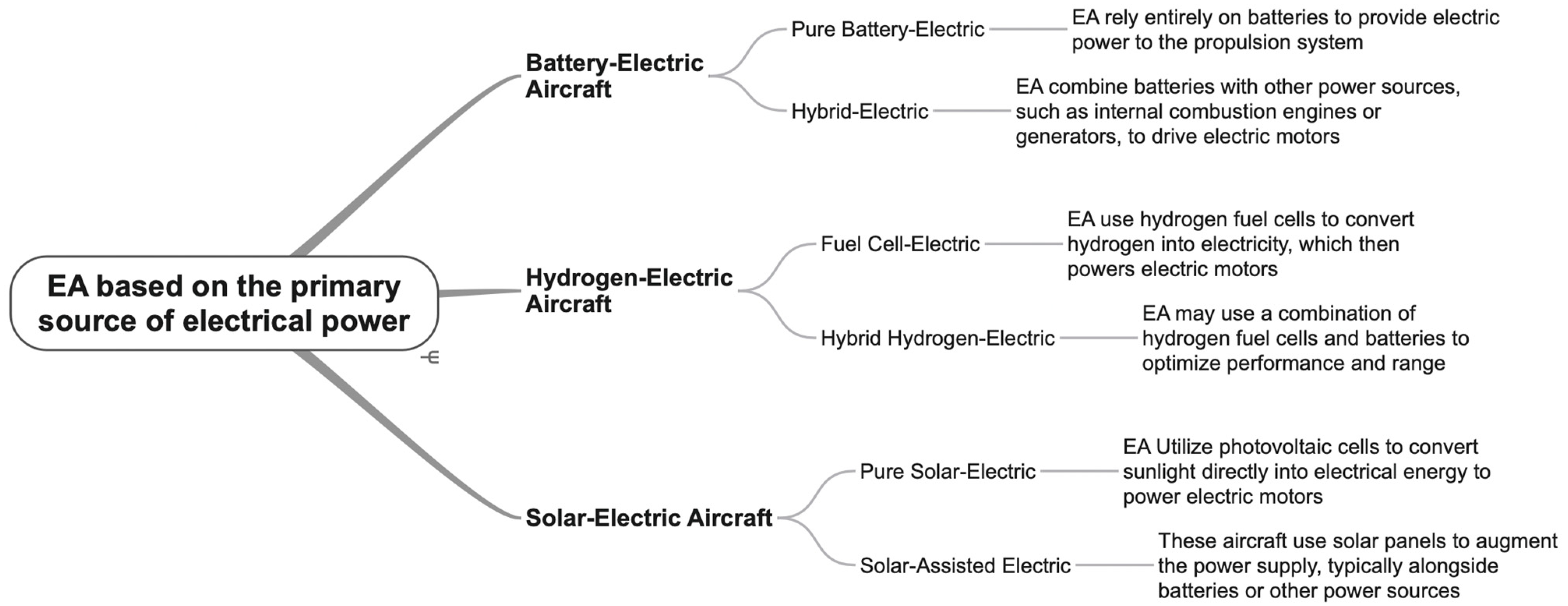

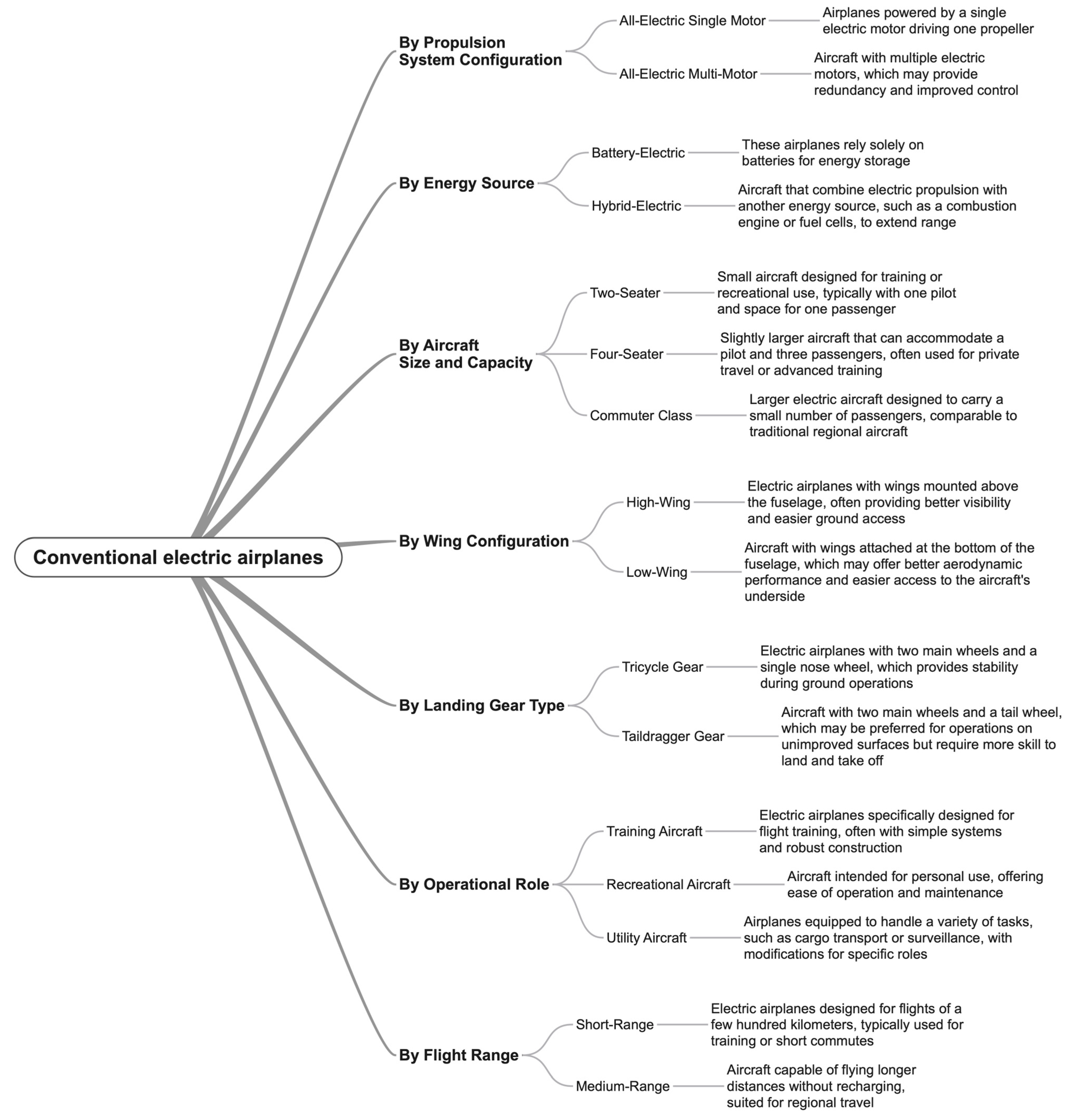
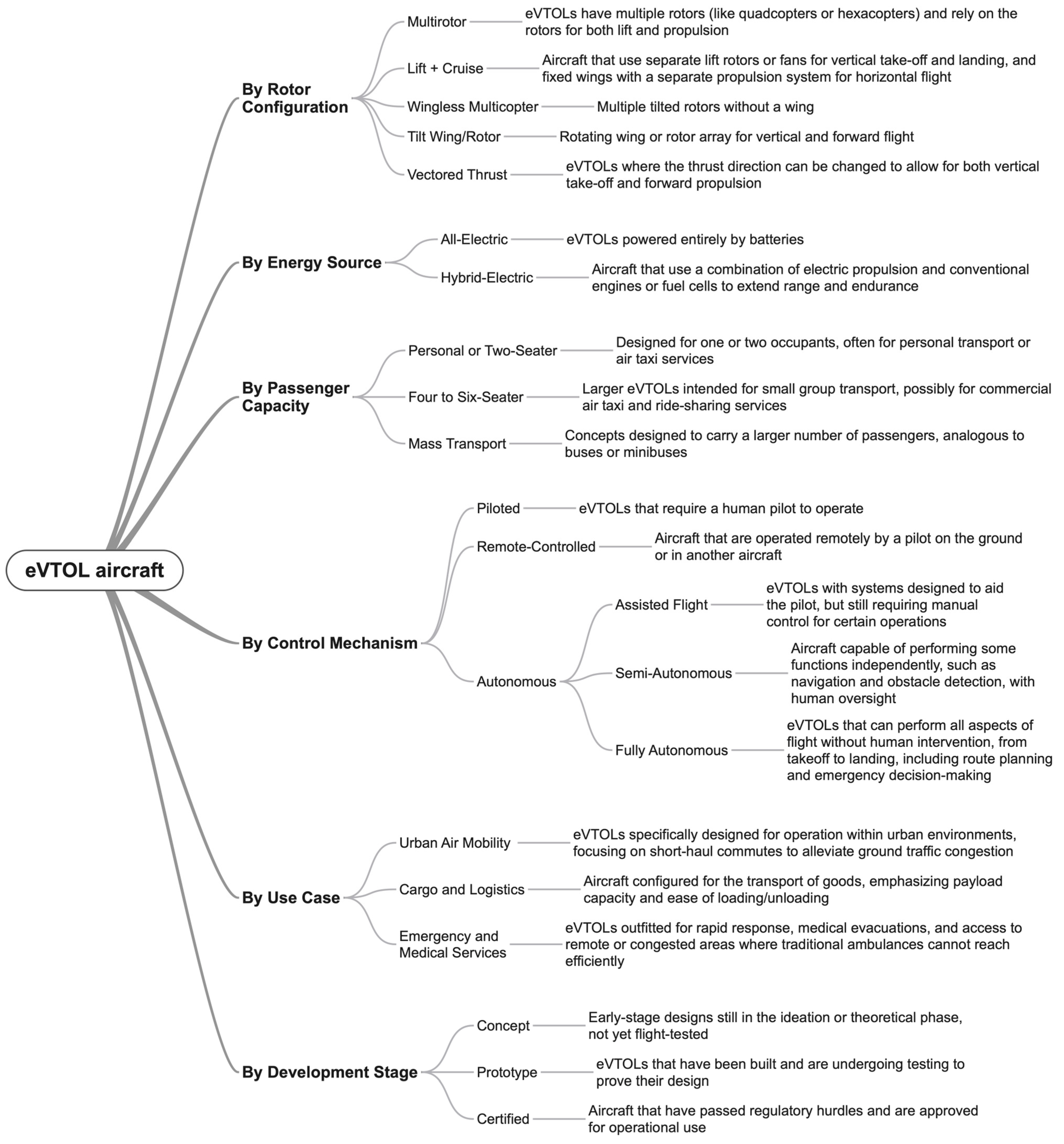

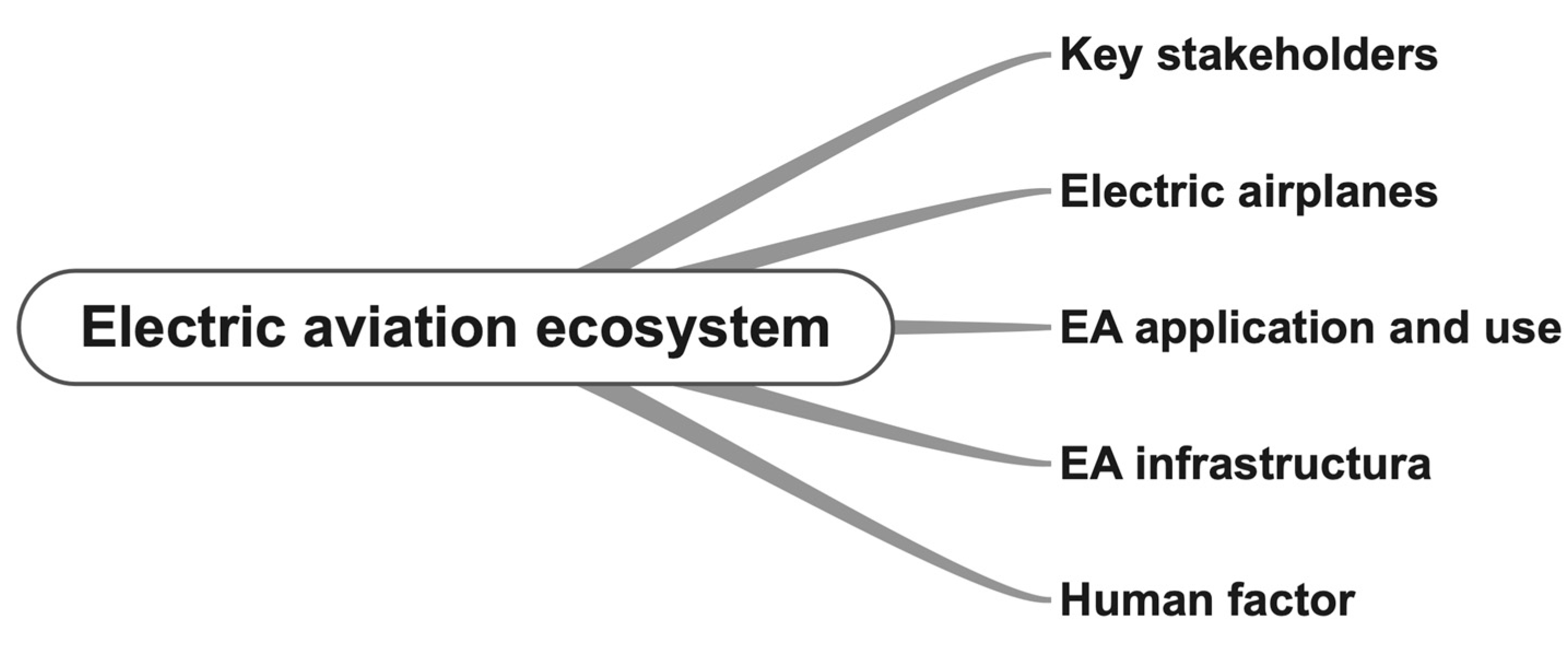
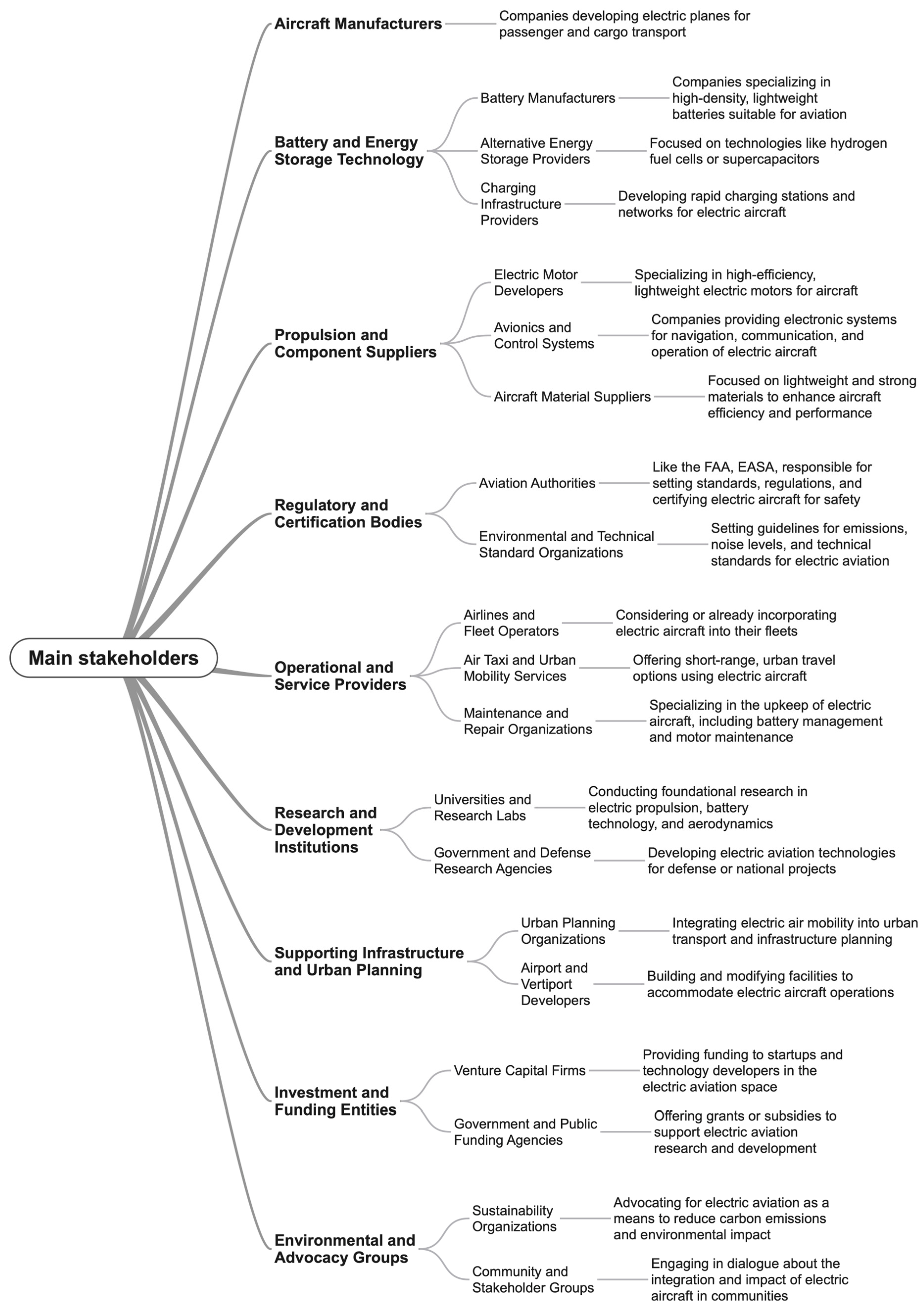

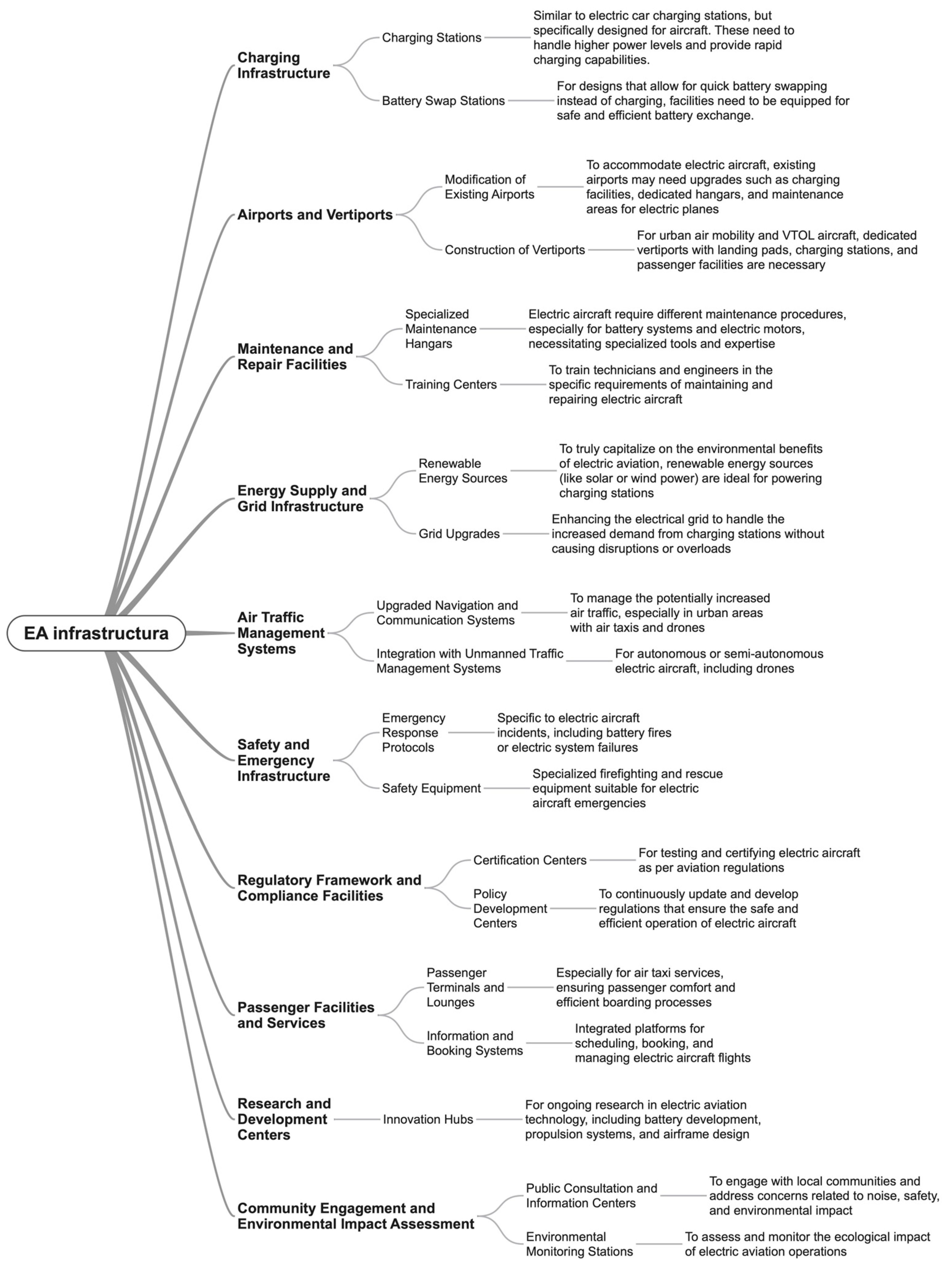
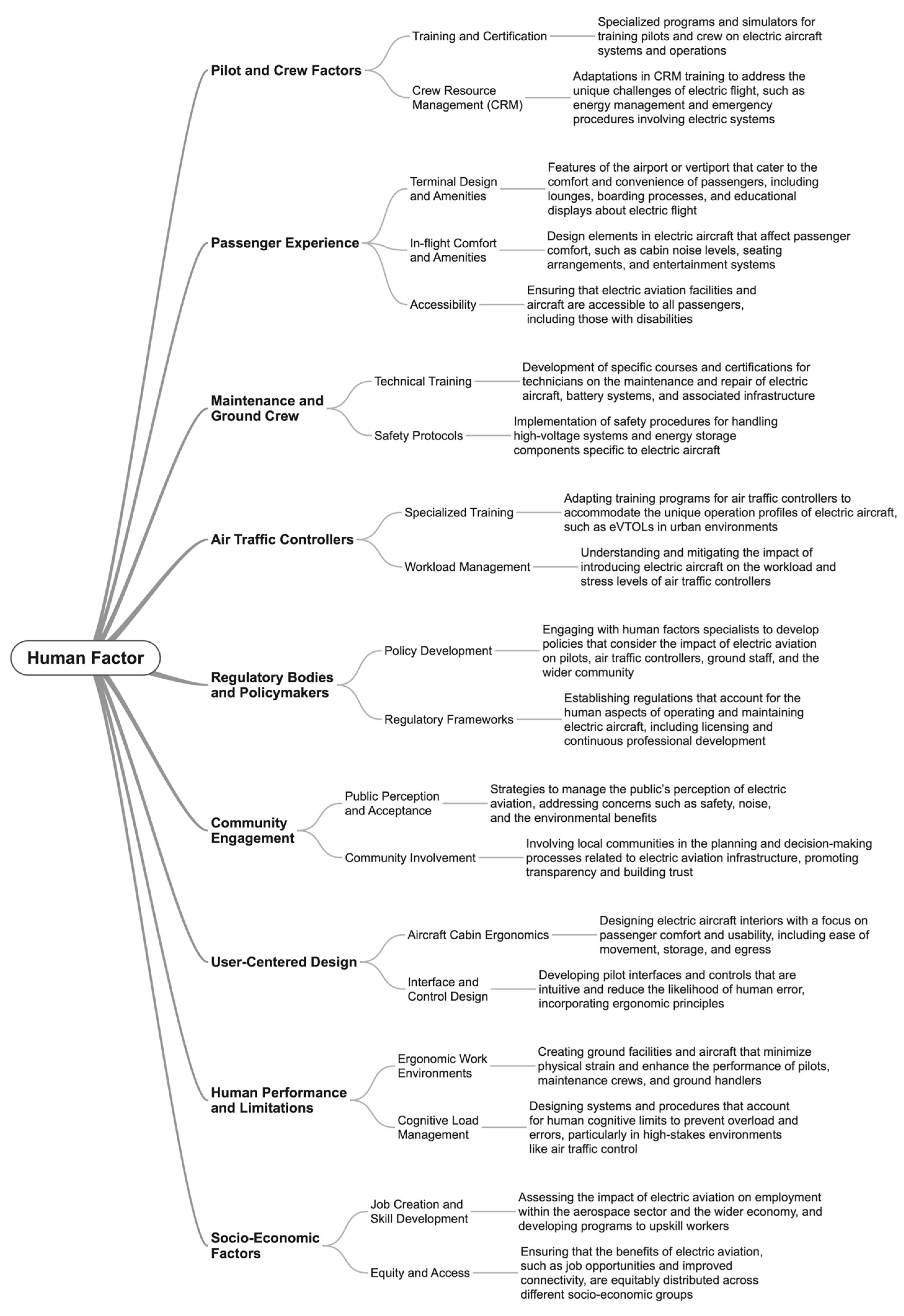
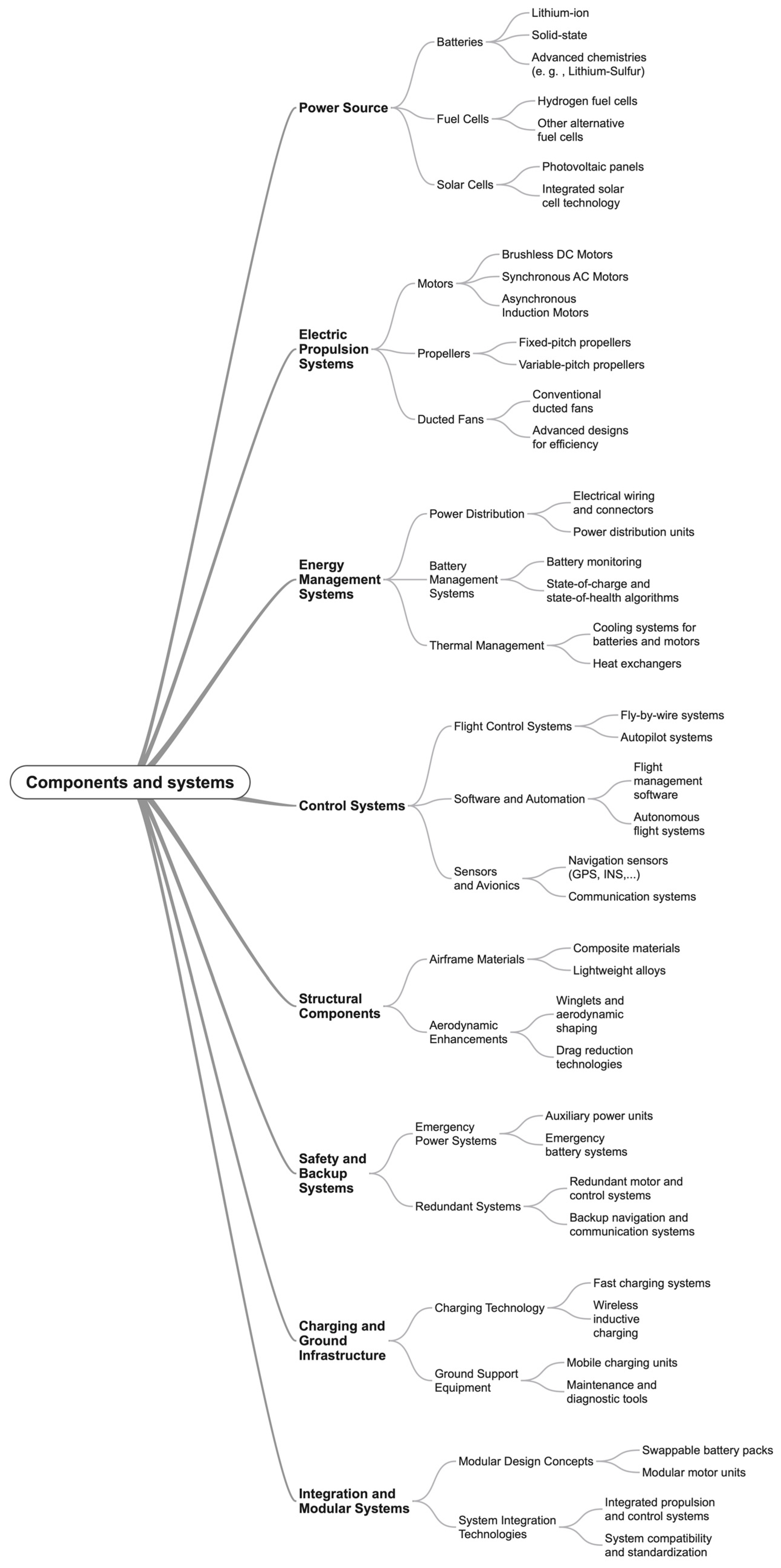
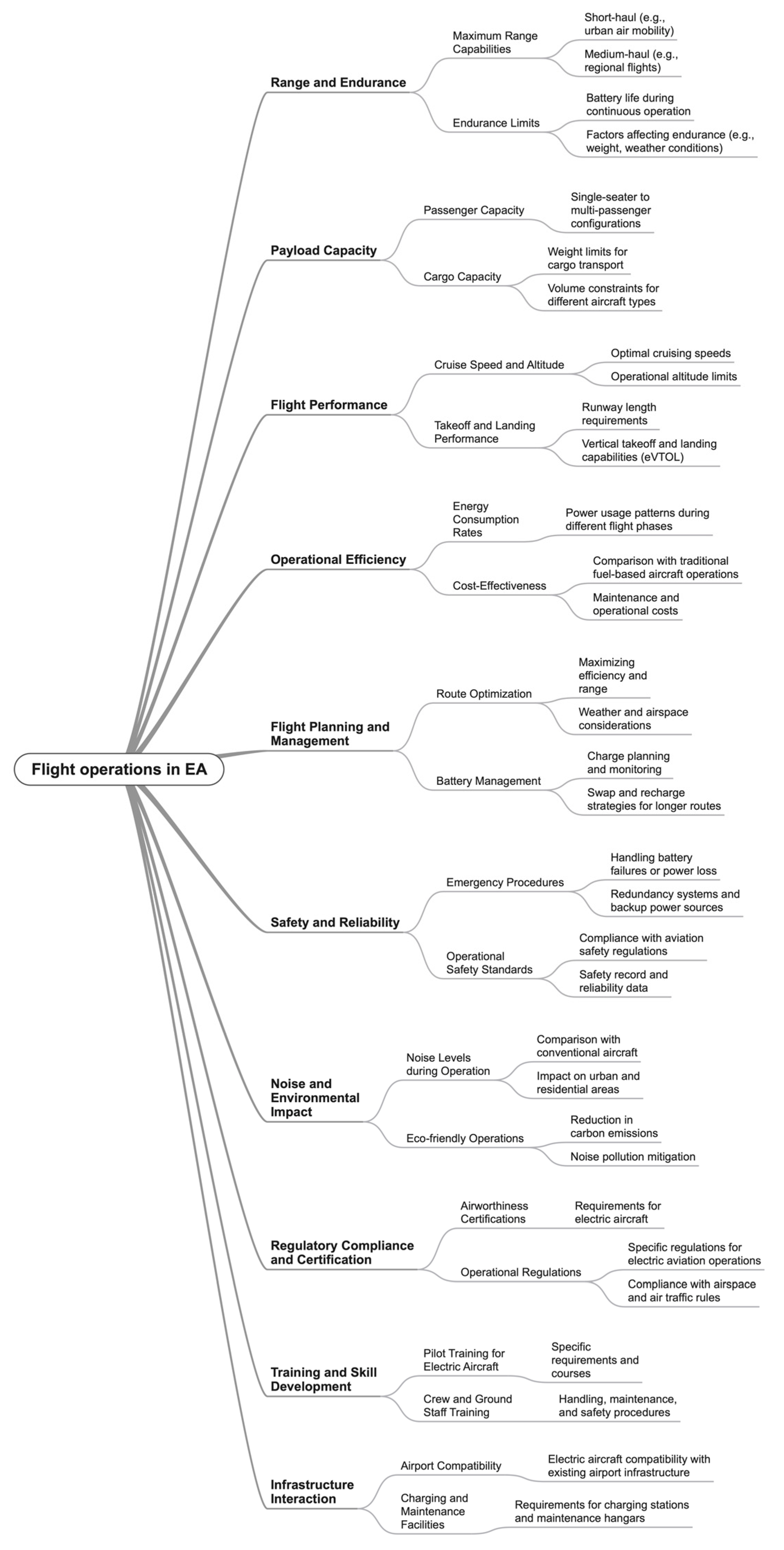
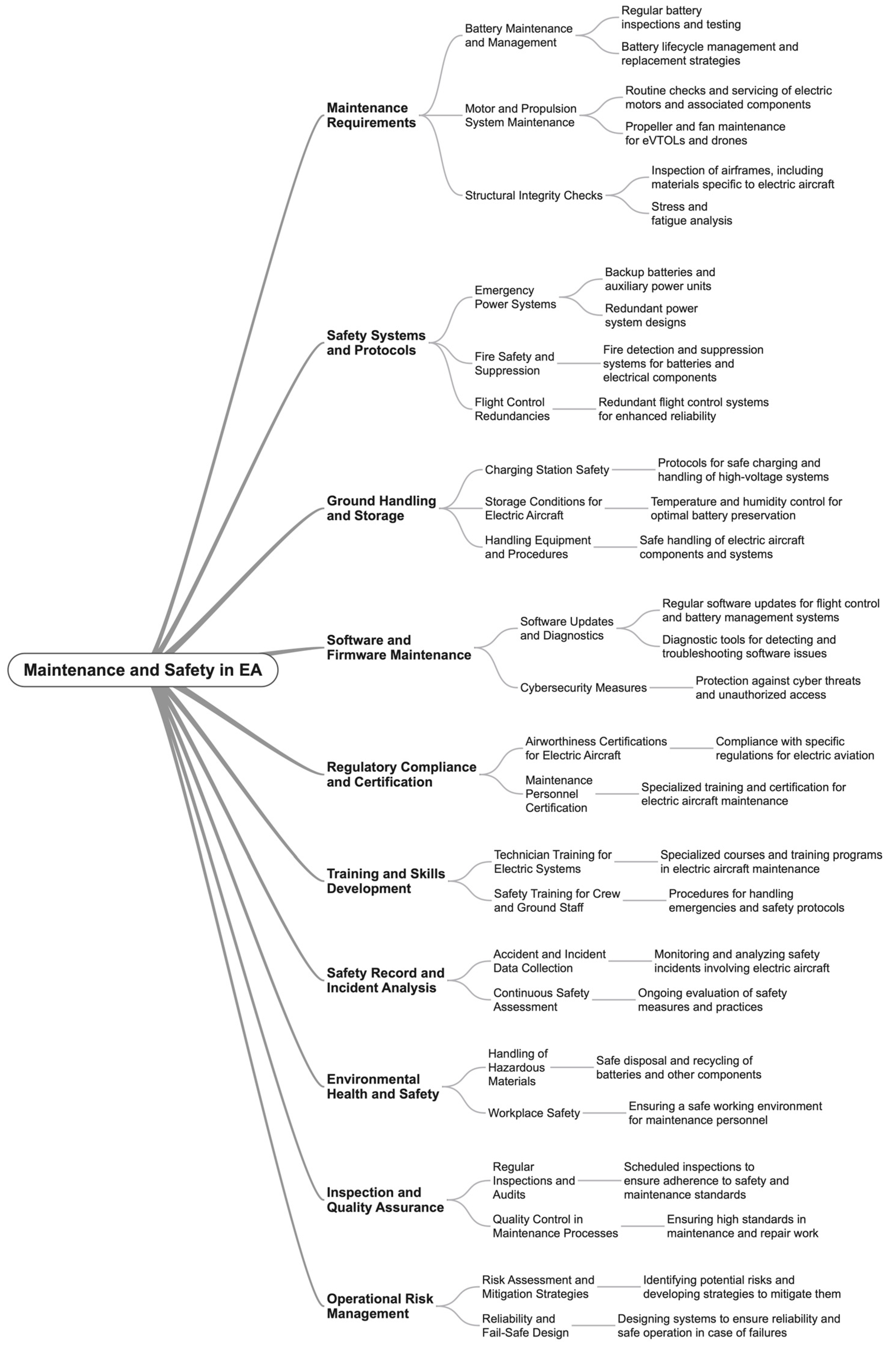



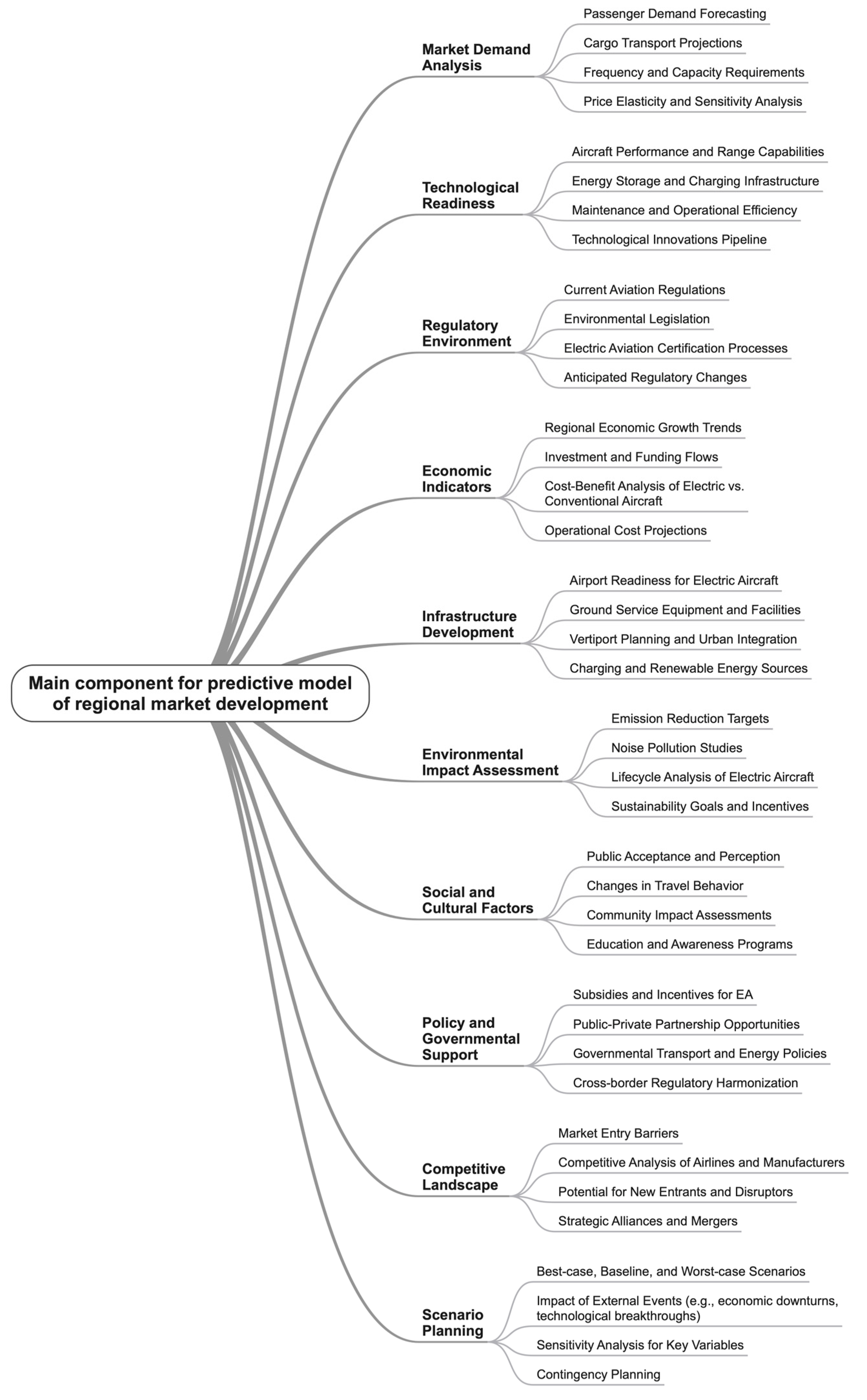
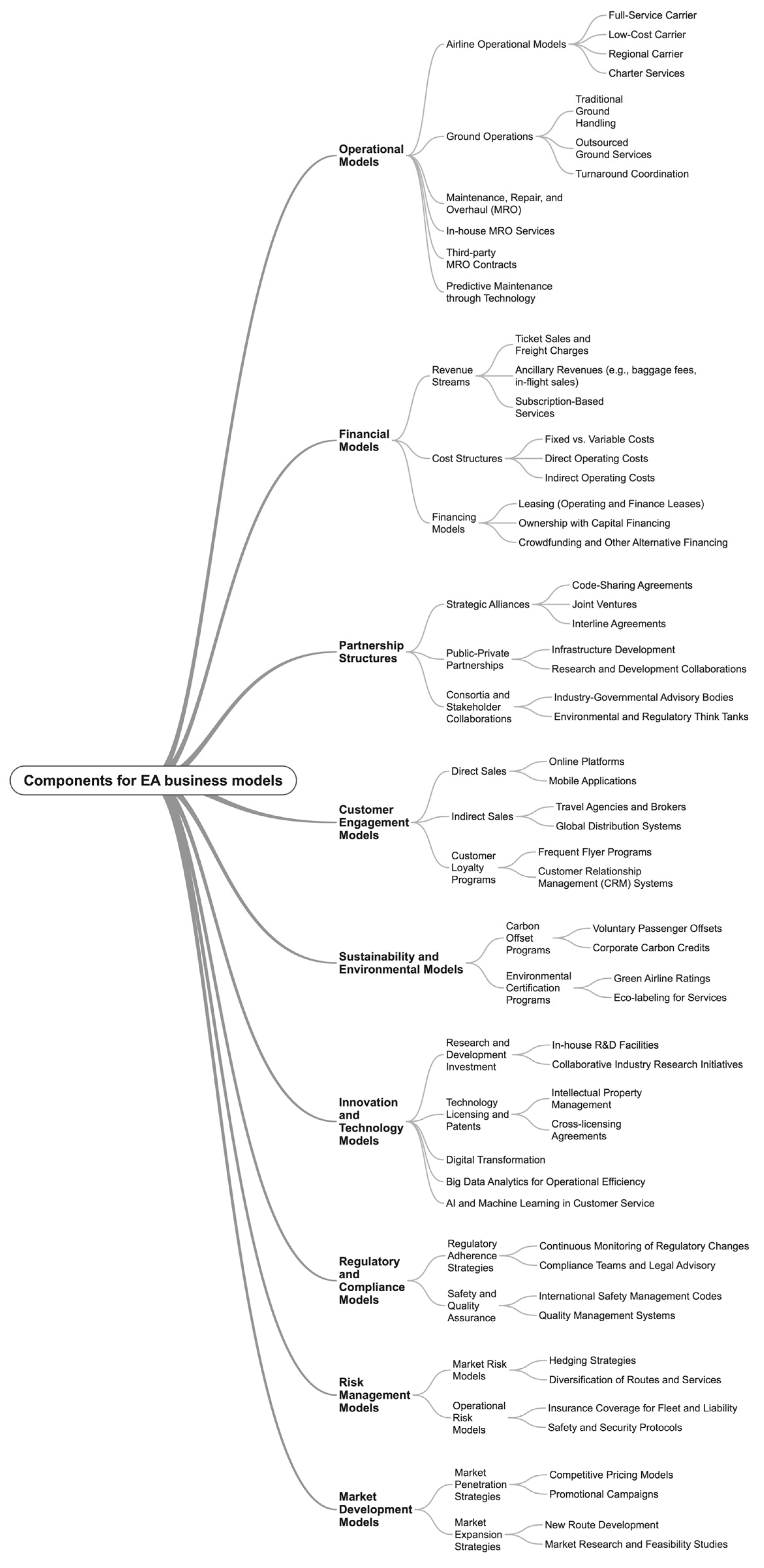
| Feature/Characteristic | Conventional Electric Airplanes | eVTOL Aircraft | eSTOL Aircraft |
|---|---|---|---|
| Aircraft Type | Fixed wing | Variety of types including multirotor, tiltrotor, etc. | Fixed wing with STOL capabilities |
| Take-Off and Landing | Requires a runway | Vertical take-off and landing | Short runways or improvised airstrips |
| Range | Medium (typically less than conventional aircraft) | Short to medium (due to weight of vertical lift systems) | Medium to long (optimized for efficient cruise flight) |
| Energy Efficiency | High (like gliders in some designs) | Lower (due to energy needed for lift) | High (due to aerodynamic efficiency) |
| Speed | Moderate | Lower than fixed-wing airplanes | Moderate to high |
| Payload Capacity | Varies, generally less due to battery weight | Usually less due to lift system weight | Comparable to conventional aircraft of similar size |
| Infrastructure Requirements | Charging stations at airports | Vertiports or retrofitted helipads with charging stations | Charging stations, possibly with shorter or modified runways |
| Operational Environment | Airports and airfields | Urban environments, hospitals, rooftops | Rural and remote areas, regional airports |
| Primary Use Cases | Short-haul commercial flights, pilot training | Urban air mobility, air taxi services, emergency services | Commercial regional transport, cargo delivery |
| Technological Complexity | Moderate | High (due to the complexity of lift and control systems) | Moderate (requires advanced aerodynamics for STOL) |
| Regulatory Hurdles | Moderate (similar to conventional aircraft) | High (new and evolving regulations) | Moderate (must meet existing aviation standards) |
| Cost Efficiency | Potentially high due to lower operating costs | Varies, currently higher due to new technology | Potentially high due to operational flexibility |
| Market Readiness | Emerging | Early stages, with ongoing demonstrations | Emerging with some models in advanced testing |
| Noise Levels | Generally lower than conventional aircraft | Low, especially compared to helicopters | Lower than conventional aircraft, varies by design |
| Environmental Impact | Reduced emissions, quieter operation | Minimal local emissions, quiet operation | Reduced emissions, quieter operation |
| Safety Features | Conventional aviation safety features plus electric system redundancy | Multiple redundancy for lift systems, often autonomous flight capabilities | Conventional aviation safety plus potential for short-field emergency landings |
| Aviation Applications | Electric Aviation Preferable | Conventional Aviation Preferable |
|---|---|---|
| Short-Haul Passenger Flights | Ideal for short distances due to limited battery range. | Longer routes where current battery technology cannot sustain the required range. |
| Urban Air Mobility | eVTOLs perfect for intra-city travel and congested areas. | Less efficient due to noise and fuel consumption. |
| Cargo Transport | Suitable for lightweight, time-sensitive cargo. | Better for heavy and long-haul cargo due to higher payload capacity. |
| Regional Connectivity | Efficient for connecting small and remote airports. | Conventional aircraft are preferred for longer regional routes. |
| Medical/Emergency Services | Quick deployment and lower noise levels are advantageous in emergency situations. | Longer range missions and heavier medical equipment transport. |
| Tourism and Sightseeing | Quieter operation is less intrusive for natural and urban scenic flights. | Longer sightseeing routes that exceed electric range capabilities. |
| Environmental Monitoring | Zero emissions and quieter operation are beneficial for ecological studies. | Extended range and endurance missions in remote areas. |
| Training and Education | Ideal for short-duration training flights with lower operational costs. | Training requiring longer flight times and diverse operational conditions. |
| Agricultural Applications | Effective for small-scale, precision agriculture operations. | Large-scale agricultural operations requiring longer flight times and heavier payloads. |
| High-Altitude Long-Endurance (HALE) Missions | Solar-electric aircraft could excel in long-duration, high-altitude surveillance and research. | Conventional aircraft for missions requiring heavy payloads and rapid response. |
Disclaimer/Publisher’s Note: The statements, opinions and data contained in all publications are solely those of the individual author(s) and contributor(s) and not of MDPI and/or the editor(s). MDPI and/or the editor(s) disclaim responsibility for any injury to people or property resulting from any ideas, methods, instructions or products referred to in the content. |
© 2024 by the author. Licensee MDPI, Basel, Switzerland. This article is an open access article distributed under the terms and conditions of the Creative Commons Attribution (CC BY) license (https://creativecommons.org/licenses/by/4.0/).
Share and Cite
Kabashkin, I. Multidimensional Taxonomies for Research, Development, and Implementation of Electric Aircraft Ecosystem. Machines 2024, 12, 645. https://doi.org/10.3390/machines12090645
Kabashkin I. Multidimensional Taxonomies for Research, Development, and Implementation of Electric Aircraft Ecosystem. Machines. 2024; 12(9):645. https://doi.org/10.3390/machines12090645
Chicago/Turabian StyleKabashkin, Igor. 2024. "Multidimensional Taxonomies for Research, Development, and Implementation of Electric Aircraft Ecosystem" Machines 12, no. 9: 645. https://doi.org/10.3390/machines12090645
APA StyleKabashkin, I. (2024). Multidimensional Taxonomies for Research, Development, and Implementation of Electric Aircraft Ecosystem. Machines, 12(9), 645. https://doi.org/10.3390/machines12090645






